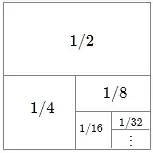This series is a geometric series and converges, see the link in the comments.
But, I'll offer the standard proof that this particular series converges here:
A series is defined to converge to $L$ if and only if the sequence of its partial sums converges to $L$:
The infinite series $ \sum\limits_{n=1}^\infty a_n$ converges to $L$ if and only if the
sequence of partial sums $\{S_n\}$, defined by
$$S_n=\sum\limits_{m=1}^n a_m =a_1+a_2+a_3+\cdots+a_n,$$ converges to
$L$.
If you consider the sum of the first $n$ terms, $S_n$, for $\sum\limits_{n=1}^\infty {1\over 2^n}$, then
$$S_n=\sum\limits_{m=1}^n{1\over2^m}.$$ Writing out this sum explicitly gives
$$
S_n={1\over 2}+{1\over 2^2}+\cdots+{1\over 2^n}.
$$
Multiply both sides of the above by $1\over2$:
$$
{1\over 2} S_n = {1\over 2^2}+{1\over 2^3}+\cdots+{1\over 2^{n+1}}
$$
Now add $1\over2$ to both sides:
$$
{1\over 2} S_n+{1\over2} =\underbrace{{1\over 2}+ {1\over 2^2}+{1\over 2^3}+\cdots+
+{1\over 2^n}}_{S_n}+{1\over 2^{n+1}}
$$
Then:
$$
{1\over 2} S_n+{1\over2} =S_n+{1\over 2^{n+1}}.
$$
Solving the above for $S_n$ gives:
$$
{1\over2}-{1\over 2^{n+1}}={1\over2}S_n
$$
$$
S_n=1-{1\over 2^n}.
$$
From the above, we can see that
as $n\rightarrow\infty$, $S_n\rightarrow1$. So $\sum\limits_{n=1}^\infty {1\over 2^n}=1$.
Or, consider the partition of the unit square:

